= Sulcorebutia swobodae K.Augustin
Kakteen Sukk. 35: 122, fig. 1984
Accepted Scientific Name: Rebutia mentosa (F.Ritter) Donald
Bradleya 5: 93. 1987
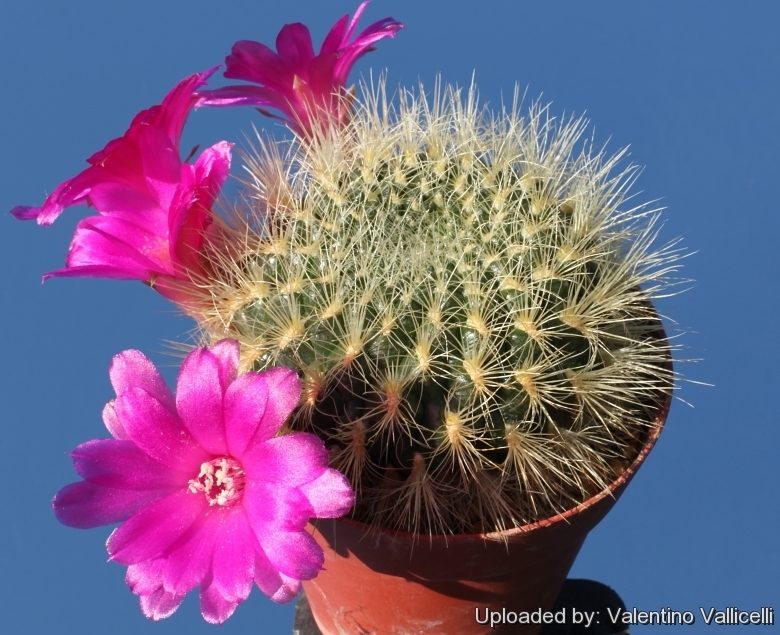
Weingartia mentosa var. swobodae (Sulcorebutia swobodae) Photo by: Valentino Vallicelli
Origin and Habitat: Between Aiquile and Mizque, Department Cochabamba, Bolivia
Altitude: 2300-2600 metres above sea level.
Synonyms:
See all synonyms of Rebutia mentosa
back
Accepted name in llifle Database:Rebutia mentosa (F.Ritter) DonaldBradleya 5: 93. 1987Synonymy: 32
Accepted name in llifle Database:Rebutia mentosa subs. purpurea (Donald & A.B.Lau) Donald ex D.R.HuntCactaceae Consensus Init. 3: 6. 1997Synonymy: 4
back
Description: Sulcorebutia swobodaeSN|15250]]SN|15250]] is one of the innumerable local form of the very variable Rebutia mentosaSN|5257]]SN|5257]] with long predominantly yellow flexible spines not hurting to the touch and pink-violet blooms. However in habitat Rebutia mentosaSN|5257]]SN|5257]] var. swobodae is very variable in colour even within the same population with spines ranging from yellow to brown to almost black. The standard Rebutia mentosaSN|5257]]SN|5257]] shows the same variably coloured spination but distinguishes in the number, texture and shape of the spines. Rebutia mentosaSN|5257]]SN|5257]] has always more or less powerful, stinging spines variously spreading or somewhat addpressed – By the other hand Rebutia mentosaSN|5257]]SN|5257]] var. swobodae has only soft, protruding "Bristles or hairs". Moreover the stems of Rebutia mentosa var. swobodae is almost concealed by the dense cover of spines that are significantly higher in number than the species.
Habit: This is one of the larger headed species, solitary or clustering when the main head is about 5-7 cm in diameter and producing a nice patch over time. This species pups at the base.
Roots: It has long tap roots.
Stem: Flattened globular or hemispherical, often shortly cylindrical in cultivation, depressed at apex, 4-7 cm tall and in diameter, typically light-green in yellow spined specimens, but in darker spined forms often brown-green, brown-violet or sometimes almost black..
Ribs: About 20, tuberculate, spiralling; tubercles with chinned protrusions.
Areoles: Elongate, white or brown woolly 5-7 mm long.
Spines: 20-25 or more per areola, not clearly differentiated as centrals and radials, about 14 mm long, comb-like, protruding and ascending, bristly, soft, fexible not hurting to the touch usually yellow, but also white, brown or black..
Flowers: Showy that cluster around the lower stem, funnel-shaped with short necks, about 3 cm tall, 3,5 cm in diameter, pink-violet to purple.
Blooming season: Spring.
Fruit: Dark yellowish-brown with pale green scales.
Subspecies, varieties, forms and cultivars of plants belonging to the Rebutia mentosa group
 Rebutia mentosa (F.Ritter) Donald: (subsp. mentosa) has dark-brown or black spines; central spines 2-4. 5-8 mm long; radial spines 14-18 about 5 mm long.
Rebutia mentosa (F.Ritter) Donald: (subsp. mentosa) has dark-brown or black spines; central spines 2-4. 5-8 mm long; radial spines 14-18 about 5 mm long. Rebutia mentosa subs. purpurea (Donald & A.B.Lau) Donald ex D.R.Hunt: has dark-green to purplish stems, with a few less radials (10-17 about 4-8 mm long), but a few more central spines (2-5, 8 -12 mm long). Spines whitish-yellow to reddish-brown. Distribution: Aiquile to Santiago, Cochabamba.
Rebutia mentosa subs. purpurea (Donald & A.B.Lau) Donald ex D.R.Hunt: has dark-green to purplish stems, with a few less radials (10-17 about 4-8 mm long), but a few more central spines (2-5, 8 -12 mm long). Spines whitish-yellow to reddish-brown. Distribution: Aiquile to Santiago, Cochabamba. Sulcorebutia albissima (F.H.Brandt) Pilbeam: Spines off-white, greyish, to light brown, pectinately arranged, lying against the surface, flowers glossy purple. Distribution: Cochabamba.
Sulcorebutia albissima (F.H.Brandt) Pilbeam: Spines off-white, greyish, to light brown, pectinately arranged, lying against the surface, flowers glossy purple. Distribution: Cochabamba. Sulcorebutia albissima f. pectinifera hort.: has very tight white pectinate spines, and the spination of well-grown specimens is pleasing. Flowers bright purple. Distribution:Cochabamba (Aiquile to Mizque)
Sulcorebutia albissima f. pectinifera hort.: has very tight white pectinate spines, and the spination of well-grown specimens is pleasing. Flowers bright purple. Distribution:Cochabamba (Aiquile to Mizque) Sulcorebutia cupreata Kníže, n.n.: has protruding white to yellowish spines. Flowers Red-purple. Distribution: Aiquile, Cochabamba, Bolivia.
Sulcorebutia cupreata Kníže, n.n.: has protruding white to yellowish spines. Flowers Red-purple. Distribution: Aiquile, Cochabamba, Bolivia. Sulcorebutia flavissima Rausch: has bright yellow spines and purple-pink flowers with paler throat. Distribution: Orkho Abuelo foot and in the adjacent areas, between Aiquile and Mizque.
Sulcorebutia flavissima Rausch: has bright yellow spines and purple-pink flowers with paler throat. Distribution: Orkho Abuelo foot and in the adjacent areas, between Aiquile and Mizque.- Sulcorebutia formosa (F.H.Brandt) Pilbeam
 Sulcorebutia mairanana hort.: This controversial plant probably correspond to Sulcorebutia albissima (a white spined form of Rebutia mentosa). Distribution: Mairana in Bolivia.
Sulcorebutia mairanana hort.: This controversial plant probably correspond to Sulcorebutia albissima (a white spined form of Rebutia mentosa). Distribution: Mairana in Bolivia. Sulcorebutia santiaginiensis Rausch: very similar (if not the same) as Rebutia mentosa subs. purpurea but with somewhat weaker spines. Distribution: Aiquile to Santiago, Cochabamba.
Sulcorebutia santiaginiensis Rausch: very similar (if not the same) as Rebutia mentosa subs. purpurea but with somewhat weaker spines. Distribution: Aiquile to Santiago, Cochabamba. Sulcorebutia swobodae K.Augustin: has long soft, flexible spines, predominantly yellow but also brown to almost black. Distribution: Between Aiquile and Mizque, Cochabamba.
Sulcorebutia swobodae K.Augustin: has long soft, flexible spines, predominantly yellow but also brown to almost black. Distribution: Between Aiquile and Mizque, Cochabamba. Sulcorebutia torotorensis (Cárdenas) F.H.Brandt: it is very similar and referable (if not the same) to Rebutia mentosa subsp. purpurea. Distribution: Torotoro, Potosi, Bolivia.
Sulcorebutia torotorensis (Cárdenas) F.H.Brandt: it is very similar and referable (if not the same) to Rebutia mentosa subsp. purpurea. Distribution: Torotoro, Potosi, Bolivia.- Sulcorebutia unguispina Rausch
Bibliography: Major references and further lectures
1) James Cullen, Sabina G. Knees, H. Suzanne Cubey “The European Garden Flora Flowering Plants: A Manual for the Identification of Plants Cultivated in Europe, Both Out-of-Doors and Under Glass” Cambridge University Press, 11/Aug./2011
2) David Hunt, Nigel Taylor “The New Cactus Lexicon” DH Books, 2006 ISBN 0953813444, 9780953813445
3) Edward F. Anderson “The Cactus Family” Timber Press, 2001
4) John Pilbeam “Sulcorebutia and Weingartia: A Collector's Guide” Timber Press, 1985
5) Cyril Marsden, Herbert Spencer Jackson “Rebutia, Including Aylostera and Sulcorebutia” Macmillan, 1968
6) Terry Hewitt “Cacti” Lorenz Books, 01/Apr/1998
7) Augustin Karl (1984): Sulcorebutia swobodae - eine Neuentdeckung aus Bolivien. Kakt. And. Sukk., 35 (6): 120-122
8) Augustin Karl, Gertel Willi, Hentzschel Günter (2000): Sulcorebutia. Verlag Eugen Ulmer, Stuttgart, pag.110
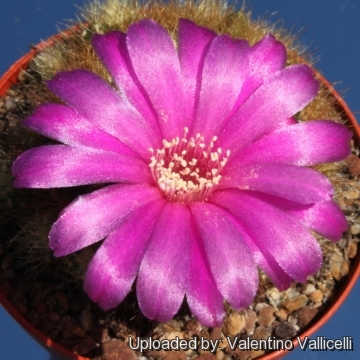 Weingartia mentosa var. swobodae (Sulcorebutia swobodae) Photo by: Valentino Vallicelli
Weingartia mentosa var. swobodae (Sulcorebutia swobodae) Photo by: Valentino Vallicelli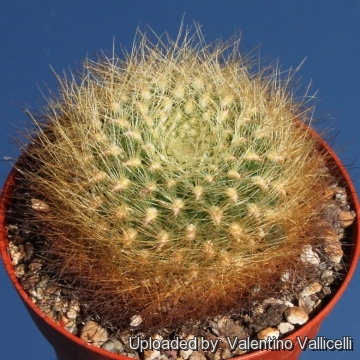 Weingartia mentosa var. swobodae (Sulcorebutia swobodae) Photo by: Valentino Vallicelli
Weingartia mentosa var. swobodae (Sulcorebutia swobodae) Photo by: Valentino Vallicelli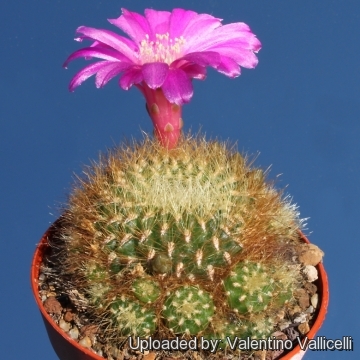 Weingartia mentosa var. swobodae (Sulcorebutia swobodae) Photo by: Valentino Vallicelli
Weingartia mentosa var. swobodae (Sulcorebutia swobodae) Photo by: Valentino Vallicelli Weingartia mentosa var. swobodae (Sulcorebutia swobodae) Photo by: Valentino Vallicelli
Weingartia mentosa var. swobodae (Sulcorebutia swobodae) Photo by: Valentino Vallicelli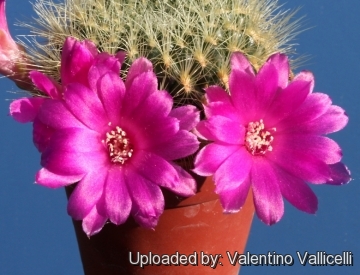 Weingartia mentosa var. swobodae (Sulcorebutia swobodae) Photo by: Valentino Vallicelli
Weingartia mentosa var. swobodae (Sulcorebutia swobodae) Photo by: Valentino Vallicelli Weingartia mentosa var. swobodae (Sulcorebutia swobodae) Photo by: Valentino Vallicelli
Weingartia mentosa var. swobodae (Sulcorebutia swobodae) Photo by: Valentino VallicelliCultivation and Propagation: Sulcorebutias are summer grower species easy to cultivate, more cold tolerant than most. These mountainous plants have thick taproots and are susceptible to overwatering. They requires also an appropriate air circulation and are sometime grafted to avoid root problems.
Growth rate: It is a relatively rapidly growing and easily flowering species that will make clumps given the best conditions.
Soils: It likes very coarse mineral cactus mix soil, but can become too elongated if compost is too rich.
Repotting: Use pot with good drainage.
Watering: Water regularly from Spring to Autumn, but do not overwater(Rot prone), it must be strictly kept dry throughout the winter quiescent period since it is very sensitive to any moisture excesseskeep dry in winter.
Fertilization: Feed with a high potassium fertilizer in summer.
Hardiness: They need to be kept in a cool place during winter rest and are somewhat resistant to frost if kept on the dry side prior to, and during, cold weather (due to the altitude they are hardy to -7 C ° C, or less for short periods). The cold is important for the flowers, as well as for their health. Without this cool winter period, they normally won't get any buds.
Exposition: Requires full sun or light shade and careful watering to keep plant compact with strong coloured spines. Tends to bronze in strong light, which encourages flowering and heavy spine production. Light shadow my be useful in the hottest summer days.
Uses: It is an excellent plant for container growing. It always looks good and stays small. It look fine in a cold greenhouse and frame or outdoor in a rockery.
Pests & diseases: It may be attractive to a variety of insects, but plants in good condition should be nearly pest-free, particularly if they are grown in a mineral potting-mix, with good exposure and ventilation. Nonetheless, there are several pests to watch for:
- Red spiders: Red sopiders may be effectively rubbed up by watering the infested plants from above.
- Mealy bugs: Mealy bugs occasionally develop aerial into the new growth among the wool with disfiguring results, but the worst types develop underground on the roots and are invisible except by their effects.
- Sciara Flies: Sciara flies are one of the major problems for seedlings. It is a good practice to mulch your seedlings with a layer of grit, which will strongly discourage the flies.
- Scales: Scales are rarely a problem.
It is wise to treat your whole collection with a systemic insecticide twice a year in spring and autumn.
- Rot: Rot is only a minor problem with cacti if the plants are watered and “aired” correctly. If they are not, fungicides won't help all that much. To prevent rottenness it is also advisable to surround its root neck by very rough sand or grit, this help a fast water drainage.
Propagation: Seed, cutting, grafting. Seeds germinate in 7-14 days at 21-27° C in spring, remove gradually the glass cover as soon the plants will be well rooted (ca 1-2 weeks) and keep ventilated, no full sun for young plants!
















